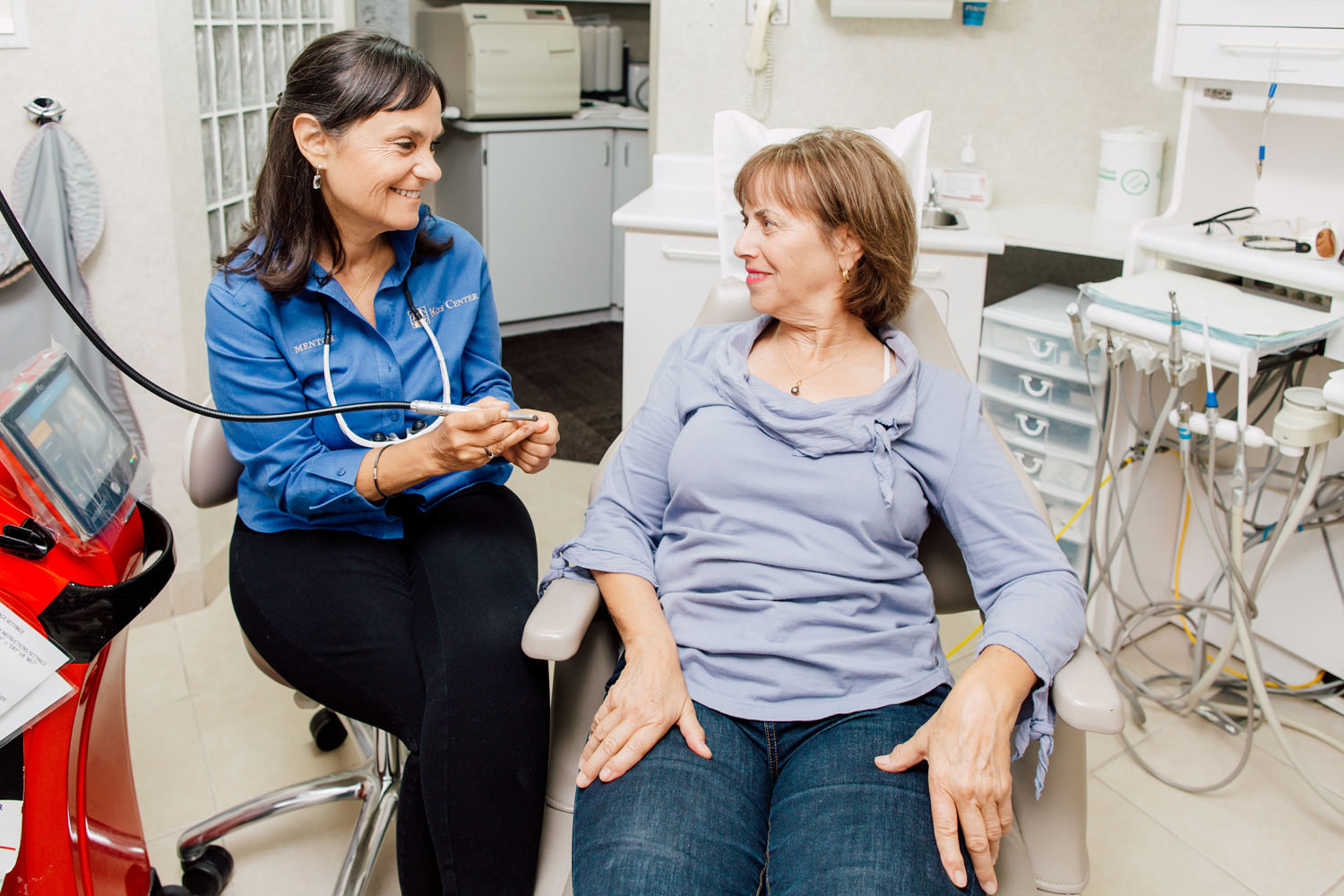Laser Dentistry

We have been using lasers since 1992!
In certain situations, our soft tissue laser removes excess gum tissue to prevent gum disease, as well as releasing tongue ties or other restrictive muscle attachments. It also recontours gummy smiles and enhances cosmetics.
The best part of the laser is that it is painless, with minimum discomfort and no bleeding. There is no “packing” or restrictions to your diet. It truly is a tool of the future in dentistry. If you get mouth sores, our lasers also alleviate the spread of herpes lesions, and eliminate pain from apthous ulcers.
Worn edges of front teeth can be reinforced with the tooth-cutting laser. This slows down the wear and eliminates rough edges. Notice edges of teeth are reinforced to prevent breakage of their enamel plate, creating much more youthful teeth.
This laser is able to remove decay. Instead of the noise and vibration of the conventional drill, we now use the quiet, touchless laser to remove old white fillings and new decay. Most of the times there is not even a need for an anesthetic because it is so painless. This laser however, does have its limitations and cannot be used to remove old amalgam fillings. This means a more comfortable experience while in the chair.
Why are we excited about our NEW WaterLase I Plus™?
Advancements in technology have evolved yesterday’s dentistry into Minimally Invasive Dentistry. When looking at technology such as the WaterLase I Plus™ it enhances the ability for shorter procedures and often no anesthetic is needed. Dental lasers offer minimal if any operative and post- op operative discomfort.
WaterLase Dentistry Clinical Uses
WaterLase was first introduced to the market in 1998, and since that time indications have expanded to include procedures on teeth, bone and gum tissue.
Laser Hard Tissue Applications
- Class I,II,III,IV and V cavity preparation
- Caries removal hard tissue surface roughening or etching
- Enamelplasty, excavation of pits and fissures for placement of sealants and sterilization
Laser Soft Tissue Applications
Soft Tissue Procedures Including Pulpal Tissues
- Excisional and incisional biopsies (selected)
- Exposure of unerupted teeth
- Fibroma removal
- Flap preparation –incision of soft tissue to prepare a flap and expose the bone
- Frenectomy
- Gingival troughing for crown impressions
- Gingivectomy
- Gingivoplasty
- Gingival incision and excision
- Hemostasis
- Implant recovery
- Incision and drainage of abscesses
- Leukoplakia, post biopsy
- Operculectomy
- Pulpotomy
- Pulp extirpation
- Pulpotomy as an adjunct to root canal therapy
- Root canal debridement and cleaning
- Reduction of gingival hypertrophy
- Soft tissue crown lengthening
- Aids in sulcular debridement (removal of diseased and inflamed soft tissue)
- Treatment of canker sores, herpetic and aphtous ulcers of the oral mucosa
- Vestibuloplasty
- Cutting, shaving, contouring and resection of oral osseous tissues(bone) (selected sites)
- Osteotomy (selected sites)

LASER ENDODONTICS
ROOT CANAL / ENDODONTIC PROCEDURES
A common concern with root canal treatment is the risk of microscopic bacteria remaining in the canals after traditional methods are preformed. Our waterlase is used to disinfect the preparation of the root canals beyond the point that bacteria can infiltrate prior to filling the canals.
OTHER LASER ENDODONTIC TREATMENTS
- Aids in root canal debridement and cleaning
- Cutting bone to prepare a window access to the apex (apices) of the roots
- Apicoectomy
- Root end preparation
LASER PERIODONTAL PROCEDURES
WaterLase iPlus™ ER,Cr:YSGG has been shown to assist in selected cases with new attachment procedure (cementum-mediated periodontal ligament new attachment to the root surface in the absence of long junctional epithelium).
Laser soft tissue curettage
Laser removal of diseased , infected, inflamed and necrosed soft tissue within the periodontal pocket
Removal of highly inflamed edematous tissue affected by bacteria
Penetration of the pocket lining and junctional epithelium
Sulcular debridement (removal of diseased or inflamed soft tissue in the periodontal pocket to improve clinical indices including gingival index, gingival bleeding index, probe depth, attachment loss and tooth mobility)
Osteoplasty and osseous recontouring (removal of bone to correct osseous defects and create physiologic osseous contours) in selected sites
Osseous crown lengthening
Aids in removal of hardened subgingival calculi in periodontal pockets with periodontitis by closed or open curettage-gross reduction
